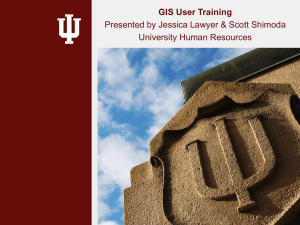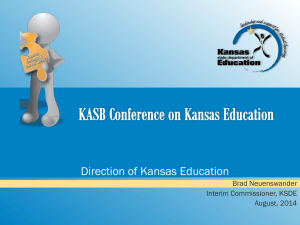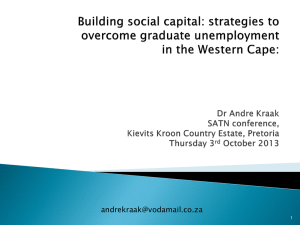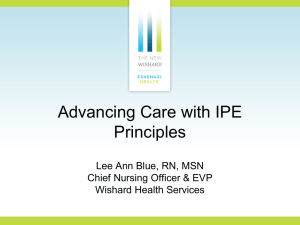Employment Outcomes of College Graduates, How Do We
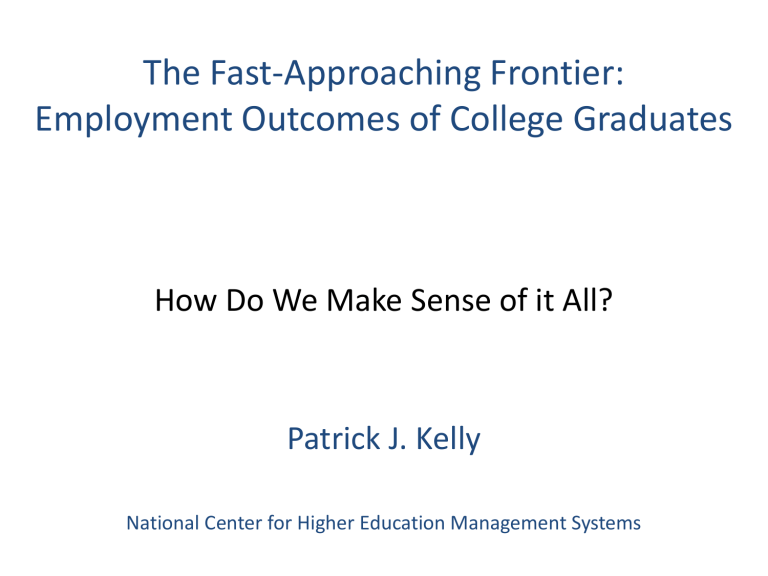
The Fast-Approaching Frontier:
Employment Outcomes of College Graduates
How Do We Make Sense of it All?
Patrick J. Kelly
National Center for Higher Education Management Systems
Environmental Pressures
• Federal Gainful Employment
• Effective utilization of federal SLDS grants
• College attainment/completion goals – state retention of graduates and economic returns
• Increased focus on “credentials of value” – the attainment of credentials of less than two-years in length (primarily) that yield living/competitive wages
• Meeting employment demand in key areas – e.g. health, education,
STEM, trades
• Increasing need for employment outcomes data to make the case for continued investment (state and federal policymaking environments)
The Data are Simple
Institution Records
• Completions
• Level of Award
(Certificate, Associates,
Bachelor’s Masters,
Doctorate, Professional)
Link
SSN
Employment/Wage Records
• Employed – record in the database (excludes self employed, military, and employed out-of-state)
• Earnings
• CIP Code of Award – Field of Study
• Industry of Employment
• Region of Employment
• Continued Enrollment
Data Available by Term Data Available Quarterly
Major Questions Answered
• What percentage of the graduates are employed instate – by level and type of award?
• Are the graduates employed in the region in which they graduate?
• What are their quarterly earnings?
• What industries are the employed in? (only relevant in a few fields)
• What percentage continue to enroll/persist in postsecondary education?
Median Annual Wages by General Field of Study and Age (United States)
(Includes Only Bachelor’s Degree Holders, Not Residents Who Earned Graduate/ Professional Degrees)
90,000
80,000
70,000
60,000
50,000
Employment
Outcomes
Metrics/
UI Data Match
40,000
STEM
Health
Business and Communications
Psychology and Social Sciences
Liberal Arts
Education
30,000
20,000
10,000
0
22 24 26 28 30 32 34 36 38 40 42 44 46 48 50 52 54 56 58 60
Age
Source: U.S. Census Bureau, 2010 American Community Survey (Public Use Microdata Sample)
Most Effective Uses of the Data
• State brain drain. Is the state retaining the graduates it produces?
How is it changing over time? (the impact on the degree and attainment goals of the state).
• State-level supply and demand. What is the employment status of graduates in key areas of demand for the state? E.g. health and
STEM fields, certain trades. Don’t fall into the trap of overly detailed program-to-occupation supply and demand studies.
• Regional supply and demand. Are institutions producing graduates that meet local employer needs? What are the employment status and wages of the graduates they produce?
• Information for students and families. What programs provide the highest wages in the short-run? What programs are more likely to require continued education upon completion?
Institutional Accountability
(Difficult at Best)
• Small numbers of graduates for many programs
• It is very difficult to calculate the “value added” by institution – i.e. the likely employment and wages of students had they not completed their college credentials
• The state economy treats graduates from some institutions better than graduates from others (with the same credentials) – the
“prestige” factor
• Institutions serving large numbers of place-bound students are victims of their local economy (e.g. a part of the state that has low wages relative to other parts of the state)
• The difficult balance between directing students into programs with competitive wages and providing student choice
Gates Foundation Voluntary Metrics Project
• Voluntary participation of 20 institutions – represented by nearly all sectors
• Pilot a few employment outcomes metrics using the match between graduate student unit records and the state unemployment insurance (UI) databases
• Data Captured: Employment, continued enrollment, and wages one and five years after graduation (by level and field of study)
• Documentation of the results, barriers, what the data tell us, what they don’t, and the most responsible/effective uses of the data in policy and practice
Context
Why Indiana?
Focus of IndianaSkills.com
Career and training opportunities associated with:
•
Levels of education that are greater than high school and less than a bachelor’s degree.
•
Typically requiring undergraduate postsecondary certificates, certifications, associates degrees.
Educational Attainment of 25 to 64 Year Olds
Indiana United States
20
15
10
5
40
35
30
25
11,2
12,6
33,5
27,0
22,4 22,2
8,6 8,4
0
Less than High
School
High School Some College, No
Degree
Associates
Degree
16,2
19,1
Bachelor's
Degree
8,2
10,7
Graduate,
Professional
Degree
Source: U.S. Census Bureau, 2009 American Community Survey
4 000
Average Annual Net Migration of 22 to 64 Year Olds by
Education Level (2005-09)
3 085
3 000 2 815
2 611
2 000
1 127
1 000
0
-1 000
-2 000
Less than High
School
High School
Graduate
Some College,
No Degree
Associates
Degree
-765
-1 581
Bachelors
Degree
Graduate or
Professional
Degree
Source: U.S. Census Bureau, 2009 American Community Survey (Public Use Microdata Samples)
30
25
20
15
10
5
0
Percent of 18 to 64 Year Olds with HS Diploma or Less Living in Families not Earning Living Wage (2010)
Source: U.S. Census Bureau, 2010 American Community Survey (Public Use Microdata Samples)
4
3
2
6
5
1
0
-1
-2
-3
-4
-5
Change in Percent of 18 to 64 Year Olds with HS Diploma or
Less Living in Families not Earning Living Wage – Since 2000
Source: U.S. Census Bureau, 2010 American Community Survey (Public Use Microdata Samples)
Supply
Information and Analysis Imposed –
A “Study”
Employers – “I’ve been telling you this for years, we can’t find people with the skills we need”
Education/Training Providers – “This is great information but you’re asking us to cut programs that generate revenue, restructure/change faculty resources, add programs that cost more to provide, and change student choice?”
Policymakers – “Interesting report but the college in my district doesn’t like it”
Potential Students – “I have no clue the report even exists, and wouldn’t read it if
I did”
Demand
Information Made Accessible –
Creating an Environment for Change
Students Employers
Information
Providers Policymakers
Access to Data and Information that
Inform Users and Generates the
Public Will for Change
Website Designed to Help:
• Job seekers find career opportunities and short term training programs that best match their skills and interests, are in high demand, with competitive wages.
• Employers learn a great deal more about the occupations they are hiring for, the skills and credentials they should be requiring, and the wages being paid to similar employees around the state.
• Students become better informed about short-term training programs that lead to gainful employment in the state and regions in which they live.
Data Sources
•
General information about occupations –
U.S. Department of Labor, MyNextMove.org,
MySkillsMyFuture.org, Bureau of Labor
Statistics, O’net
•
Real-time data on occupation demand –
Burning Glass
•
Status of recent college graduates –
Indiana’s W
orkforce Intelligence System (IWIS).
Most Job Postings for Sub-Baccalaureate Occupations
(Source: Burning Glass)
Heavy and Tractor-Trailer Truck Drivers
Retail Salespersons
Registered Nurses
Sales Representatives, Wholesale and Manufacturing
First-Line Supervisors of Retail Sales Workers
Customer Service Representatives
Maintenance and Repair Workers, General
Light Truck or Delivery Services Drivers
First-Line Supervisors of Food Preparation and Serving Workers
Executive Secretaries and Executive Administrative Assistants
Secretaries and Administrative Assistants
General and Operations Managers
Laborers and Freight, Stock, and Material Movers, Hand
Office Clerks, General
Licensed Practical and Licensed Vocational Nurses
First-Line Supervisors of Production and Operating Workers
Nursing Assistants
Stock Clerks and Order Fillers
Industrial Production Managers
First-Line Supervisors of Office and Administrative Support Workers
Tellers
Computer User Support Specialists
Food Service Managers
Merchandise Displayers and Window Trimmers
Cashiers
Bookkeeping, Accounting, and Auditing Clerks
Installation, Maintenance, and Repair Workers, All Other
Janitors and Cleaners, Except Maids and Housekeeping Cleaners
Insurance Sales Agents
Automotive Service Technicians and Mechanics
Health Technologists and Technicians, All Other
Cooks, Restaurant
Production Workers, All Other
Personal Financial Advisors
Receptionists and Information Clerks
0
17,374
13,059
11,952
11,501
14,938
8,198
2,491
2,428
2,338
2,334
2,221
2,212
2,186
2,140
2,100
2,089
1,962
1,908
1,829
4,042
3,935
3,460
3,358
3,104
2,826
2,541
2,536
2,512
2,500
5,097
5,079
4,837
4,609
4,523
4,304
2,000 4,000 6,000 8,000 10,000 12,000 14,000 16,000 18,000 20,000
Most Requested/Required Certifications
(Source: Burning Glass)
REGISTERED NURSE
LICENSED PRACTICAL NURSE (LPN)
COMMERCIAL DRIVER'S LICENSE
CERTIFIED NURSING ASSISTANT
CDL CLASS A
FIRST AID CPR AED
AUTOMOTIVE SERVICE EXCELLENCE (ASE) CERTIFICATION
FIRST AID CPR AED
FORKLIFT OPERATOR CERTIFICATION
CERTIFIED OCCUPATIONAL THERAPY ASSISTANT
COMMERCIAL DRIVER'S LICENSE
FIRST AID CPR AED
AUTOMOTIVE SERVICE EXCELLENCE (ASE) CERTIFICATION
LICENSED VOCATIONAL NURSE (LVN)
SERIES 6
CDL CLASS A
INSURANCE LICENSE
REGISTERED NURSE
CERTIFIED MEDICAL ASSISTANT
BASIC CARDIAC LIFE SUPPORT CERTIFICATION
PHLEBOTOMY CERTIFICATION
COMMERCIAL DRIVER'S LICENSE
CERTIFIED PHARMACY TECHNICIAN
CERTIFIED SURGICAL TECHNOLOGIST
REGISTERED HEALTH INFORMATION TECHNICIAN
ADVANCED CARDIAC LIFE SUPPORT (ACLS) CERTIFICATION
CERTIFIED A+ TECHNICIAN
INSURANCE LICENSE
REGISTERED RESPIRATORY THERAPIST
FORKLIFT OPERATOR CERTIFICATION
FIRST AID CPR AED
REGISTERED HEALTH INFORMATION ADMINISTRATOR
INDIANA CERTIFIED NURSE AIDE
HOME HEALTH AIDE
SERIES 7
0
249
241
230
214
210
201
200
195
194
186
174
169
167
379
376
338
335
329
300
586
563
843
1,118
557
511
505
489
461
452
418
1,000 2,000
2,193
2,077
2,039
1,962
3,000 4,000 5,000 6,000
7,528
7,000 8,000
Status of Recent College Graduates
(Source: Indiana’s Workforce Intelligence System)
Example – Registered Nurses
5,000
4,500
4,000
3,500
3,000
2,500
4,521
2,000
1,500
1,000
465
500
0
Graduates from
2008-09 to
2009-10
Continued
Education
3,665
391
Employed in
Indiana
Not Employed,
Self Employed,
Employed Out of
State
60,000
50,000
40,000
30,000
31,856
56,200
20,000
10,000
0
Average Earnings One
Year After Graduation
Average Earnings for All
Registered Nurses
Data and Information
Available by Region
Gary South Bend
Fort Wayne
Lafayette
Indianapolis
Terre Haute
Bloomington Columbus
Richmond
New Albany
Evansville
Additional Features
•
“Top 10 Lists” –
e.g. Occupations with greatest demand, highest earnings, highest percentage of employability, most requested certifications by Indiana employers, most requested specialized skills by Indiana employers, etc.
•
Job Description Creator
– an easy-to-use tool that enables employers to generate job descriptions for occupations they are hiring for – utilizing the data and information on the website (e.g. typical level of education required, certifications associated with the occupation, wages earned by Indiana employees, etc.)


